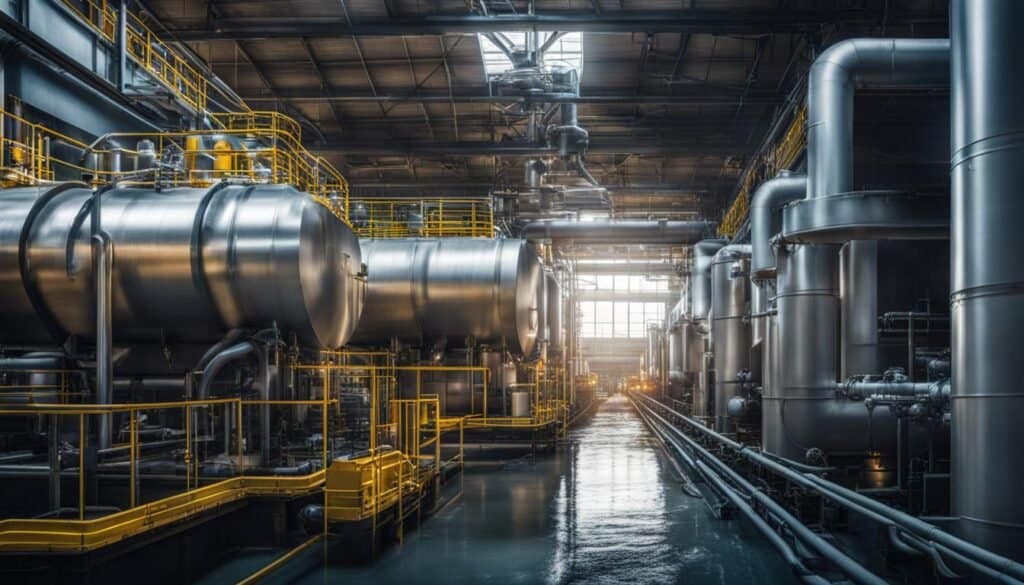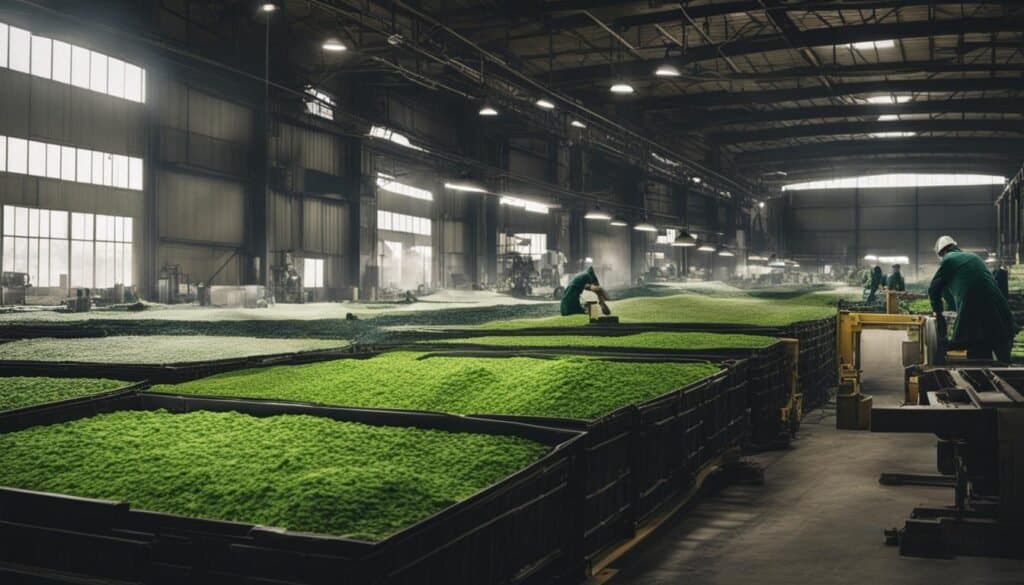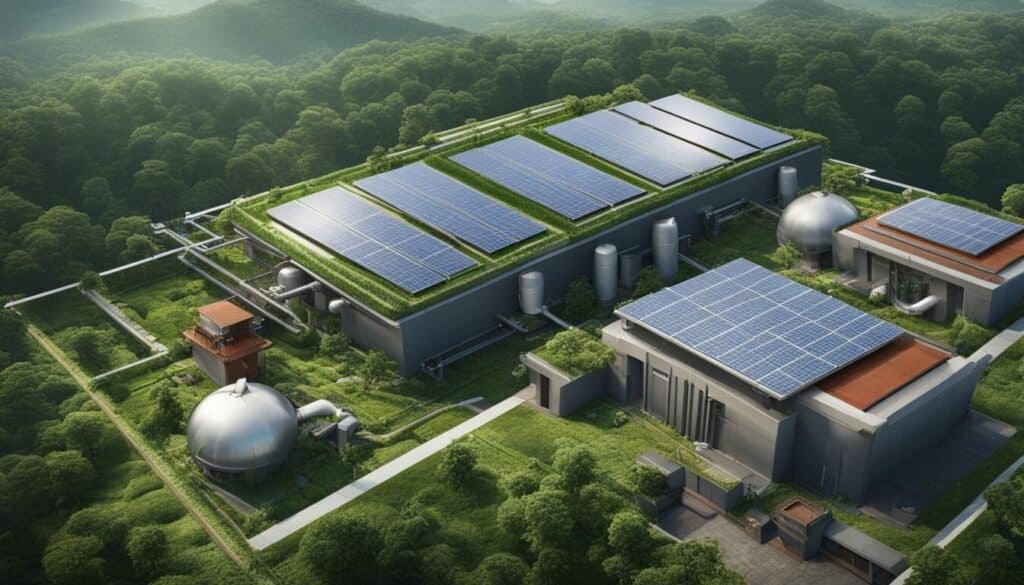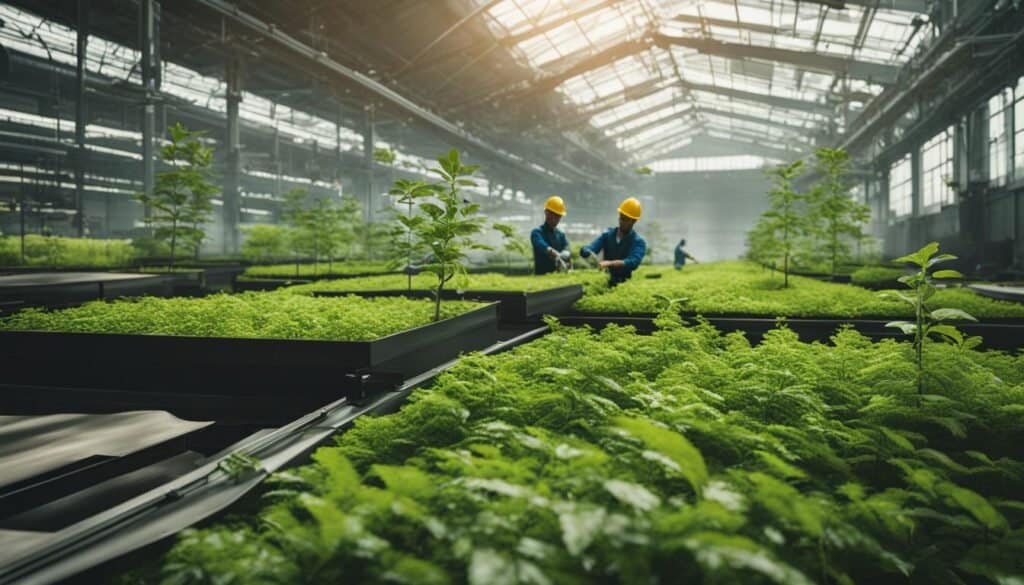As a professional journalist, it is my pleasure to discuss the important topic of sustainability in manufacturing. With increasing global concerns about the environmental impact of manufacturing practices, it has become vital for companies to adopt sustainable practices to reduce their environmental footprint. As we explore the world of factory floor sustainability, we will delve into key aspects such as energy usage, resource conservation, and the integration of renewable resources into the manufacturing process.
From the factory floor to the delivery of finished products, the implementation of sustainable measures can have a significant impact on the environment and the businesses that prioritize them. Moreover, embracing such practices is not only beneficial for the planet but also offers operational efficiencies and increased competitiveness in the market. So, let’s dive in and learn about the importance of sustainability in manufacturing and the strategies manufacturers can employ to minimize their environmental impact.
Key Takeaways
- Factory floor sustainability is an essential aspect in addressing and mitigating the environmental impact of manufacturing practices.
- Reducing energy consumption through energy-efficient measures and renewable resources is critical to promoting sustainable manufacturing.
- Resource conservation ensures a more efficient production process while diminishing waste and emissions.
- Innovative technologies play a significant role in optimizing manufacturing processes for sustainability.
- Adopting sustainable practices can result in economic benefits, operational efficiency, and increased competitiveness for businesses.
- Regulatory compliance and collaboration with industry partners contribute to the successful implementation of sustainable manufacturing initiatives.
- Manufacturers play a vital role in global sustainability goals and environmental preservation through responsible practices.
Embracing the Philosophy of Sustainable Manufacturing
Adopting the philosophy of sustainability in manufacturing demands a comprehensive approach that encompasses every aspect of the manufacturing value chain, from design and sourcing to production and delivery. The journey towards sustainable manufacturing begins with measuring a facility’s carbon footprint and undertaking scenario planning rooted in data capable of withstanding rigorous auditing processes.
Implementing sustainability initiatives often involves creating new roles, such as Chief Sustainability Officers, and prioritizing sustainability metrics for strategic investments. Coordination and cooperation with ecosystem partners like industry associations and regulators are essential for the successful adoption of environmental sustainability measures.
“Today, manufacturers of physical products find themselves on the front lines of sustainability, with customers demanding cleaner, lower-carbon products, as seen in the high-tech sector with Apple’s targets for reducing Scope 1 and Scope 2 emissions and Polestar’s mission to create a climate-neutral car by 2030” – McKinsey.
Mastery of sustainable manufacturing enables businesses to create positive, impactful narratives about their operations and their contributions towards reducing greenhouse gas emissions, ultimately improving transparency and strengthening market positioning. Setting the right leadership tone and cultivating organizational commitment to sustainability fuels continuous innovation, social value creation, increased market competitiveness, and significant improvements in operational efficiency.
“The successful integration of sustainable practices includes setting the right leadership tone and fostering organizational commitment, which will fuel continuous innovation, social value, increased market competitiveness, and substantial efficiency improvements.”
Embracing the philosophy of sustainable manufacturing requires a firm commitment to change management and a willingness to invest in sustainable life cycle design and eco-design principles. These practices result in greener, more efficient, and cost-effective operations over time, further encouraging businesses to become champions of sustainability.
| Sustainable Manufacturing Aspects | Actionable Steps |
|---|---|
| Carbon footprint measurement | Track and analyze facilities’ carbon profiles |
| Organizational commitment | Create sustainability-focused roles (e.g., Chief Sustainability Officer) and prioritize sustainability metrics |
| Ecosystem partners | Engage industry associations and regulators for collaborative efforts |
| Public narratives | Highlight environmental contributions and showcase the company’s commitment to sustainability |
| Change management | Integrate sustainable life cycle design and eco-design principles to transform operations |
As more businesses adopt a sustainable mindset, the manufacturing sector will continue to evolve, paving the way for healthier, more eco-friendly, and efficient practices that protect our planet for generations to come.
Energy Consumption: The Manufacturing Sector’s Achilles Heel
The substantial energy consumption involved in manufacturing processes has long been known as a significant contributor to environmental concerns. As global demand for manufactured goods continues to rise, so does the importance of addressing the energy consumption and its impact on our planet. This section will explore the potential of renewable energy sources and the role of digital technology in improving energy efficiency within the manufacturing sector.
The Role of Renewable Energy Sources in Manufacturing
Renewable energy sources, such as solar panels, geothermal pumps, and wind turbines, offer an alternative to traditional energy sources that can help reduce the environmental impact of manufacturing processes.
In addition to increasing energy efficiency, adopting renewable energy systems can reduce greenhouse gas emissions, aligning with global sustainability goals. For example, progressive companies are using power purchasing agreements to secure long-term, cost-competitive energy supplies from renewable sources, helping to mitigate rising energy costs and lessen their overall carbon footprint.
Digital Technology’s Impact on Energy Efficiency
Digital technology has revolutionized manufacturing, bringing significant improvements in productivity and safety while reducing operational costs. With the growing prevalence of automation and digital technology in manufacturing, there is a clear opportunity to further enhance energy efficiency across production processes. By providing detailed insights into production equipment, machine conditions, and energy consumption patterns, smart manufacturing technologies enable manufacturers to minimize waste and carbon emissions.
| Technology | Benefits |
|---|---|
| Automation Systems | Reduced energy loads, improved production efficiency, and minimized waste |
| Predictive Maintenance | Proactive equipment maintenance, reduced energy consumption, and optimized operations |
| Lean Processes | Resource optimization, elimination of non-value-added activities, and minimized energy use |
| Energy Management Systems | Energy use monitoring and control, increased efficiency, and reduced emissions |
Incorporating intelligent systems that manage and automate energy consumption in manufacturing can help companies reduce their carbon footprints and better adhere to evolving environmental regulations. By leveraging digital technology and renewable energy solutions, manufacturers can transform their conventional practices into more sustainable, eco-friendly processes for long-term success.
Reducing Carbon Footprints Through Innovative Manufacturing Processes
Reducing carbon footprints in manufacturing requires a strategic approach that revolves around the adoption of innovative techniques, as part of a sustainable manufacturing strategy. This involves rethinking traditional production methods to make them more resource-efficient, ultimately shaping a greener and eco-friendlier future for industry players.
- Lean Manufacturing: Lean manufacturing emphasizes the elimination of waste and maximization of value in the production process. By employing lean strategies, manufacturers can improve resource utilization, considerably reducing their environmental impact.
- Additive Manufacturing: Additive manufacturing, often referred to as 3D printing, significantly reduces material usage and waste generation by creating parts and objects layer by layer, as opposed to subtractive techniques like machining.
- Life Cycle Assessment: Taking a full life cycle perspective on products enables manufacturers to identify and minimize their environmental impact throughout every stage—from raw material extraction to end-of-life disposal or recycling.
Implementation of these innovative manufacturing processes has led to visible benefits, such as substantial reduction of greenhouse gases and substantial steps towards carbon-neutral manufacturing operations. The following table showcases the potential impact of these manufacturing techniques:
| Manufacturing Technique | Environmental Impact Reduction |
|---|---|
| Lean Manufacturing | Reduction in resource waste and energy consumption |
| Additive Manufacturing | Decreased material usage and waste generation |
| Life Cycle Assessment | Overall reduction in environmental impact throughout the product life cycle |
“Innovative manufacturing processes are not just a trend, but a necessary step towards a sustainable future in the industry.”
Moving forward, it is essential for manufacturers to continually explore and adopt innovative processes that promote resource-efficient production and work towards reducing their carbon footprint. With the combined use of lean manufacturing, additive manufacturing, and life cycle assessment methodologies, manufacturers can play a vital role in minimizing their environmental impact and contribute to a more sustainable future for the industry.
Water Stewardship and Waste Management in Industrial Practice

Water stewardship and waste management are pivotal components of sustainable industrial practice, playing a significant role in reducing the environmental impact of various industries. The advancements in toxic waste disposal and efforts to prevent water contamination have led to improved industrial water management strategies and a reduced risk of pollution. This, in turn, ensures compliance with environmental regulations while optimizing effluent management and promoting clean water initiatives.
Advancements in Toxic Waste Disposal
Notable progress in toxic waste disposal is driving change in sustainable waste management practices. The development of efficient industrial waste treatment technologies and integrated waste management strategies prevents the release of toxic effluents into the environment, protecting public health and preserving ecosystems. Some examples of such advanced disposal methods include:
- Zero-discharge systems
- Sustainable water use
- Industrial water innovation
By employing these cutting-edge methodologies, industries can demonstrate responsible water stewardship and align with broader sustainability goals.
Efforts to Prevent Water Contamination
Preventing water contamination is an essential aspect of sustainable industrial practice. To achieve this, companies must implement a combination of stringent effluent management systems, closed-loop water systems, and innovative treatment methodologies. This multi-faceted approach ensures pollution prevention and significantly reduces the risk of water contamination. Some key strategies employed by industries to maintain water quality standards and minimize waste include:
- Environmental regulations compliance
- Effluent optimization
- Clean water initiatives
- Waste minimization
Adherence to these strategies drives innovation in sustainable water use, ultimately fostering responsible industrial water management and supporting environmental preservation.
Sustainable Material Sourcing and the Circular Economy

As the world moves toward more eco-conscious practices, sustainable material sourcing is becoming a central aspect of the manufacturing process. By focusing on renewable materials and integrating recycled content into production lines, companies can reduce their resource footprint and align with global goals for responsible resourcing.
Focus on elimination and be segregation savvy by following waste hierarchy principles throughout the production process, and use color-coding, clear signage, and graphics to ensure proper waste disposal – IMECHE.
Embracing green procurement strategies and evaluating raw material choices from a life cycle perspective can help businesses mitigate their environmental impact while supporting a circular and regenerative economic model.
Sustainable material sourcing is a key component of the circular economy in manufacturing, promoting resource conservation, and reducing waste generation.
Green Procurement and the Role of Renewable Materials
Green procurement involves the systematic inclusion of environmental requirements in purchasing decisions, taking into account the full life cycle of products. This approach encourages businesses to procure goods and services that minimize ecological effects during their production, use, and disposal phases. Manufacturers adopting green procurement strategies can enhance supply chain sustainability and overall environmental performance.
One of the critical elements of green procurement is the use of renewable materials. These are resources that can be regenerated or replaced within a relatively short timeframe, such as bamboo, cork, organic cotton, and bioplastics derived from plant-based sources. By selecting renewable materials, manufacturers not only contribute to resource conservation but also strengthen their commitment to eco-responsibility.
Recycled Content and Environmental Impact Reduction
Incorporating recycled content into the production process is another effective method of promoting sustainable material sourcing. By utilizing recycled materials, manufacturers can:
- Reduce the demand for virgin materials
- Minimize waste generation
- Conserve energy and water resources
- Lower greenhouse gas emissions
Recycled content products are becoming more prevalent in various industries, such as construction, packaging, and textiles. As an example, the use of post-consumer recycled plastic in the creation of new packaging materials not only helps to decrease waste but also presents an opportunity for businesses to showcase their commitment to environmentally responsible sourcing practices.
Fostering a Circular Economy through Sustainable Material Sourcing
The circular economy is an economic model that aims to eliminate waste and minimize resource use by enabling materials to be reused, remanufactured, or recycled at the end of their life cycle. Manufacturers supporting a circular economy approach can reduce their environmental impact while boosting cost-efficiencies and overall sustainability.
Some best practices for sustainable material sourcing within a circular economy framework include:
- Designing products for easy disassembly and recyclability
- Implementing reverse logistics systems to reclaim end-of-life products
- Collaborating with suppliers committed to sustainable practices
- Participating in industry-wide initiatives that promote resource stewardship and mindful consumption
By embracing sustainable material sourcing strategies, manufacturers can drive their businesses towards a more circular, sustainable, and regenerative future while simultaneously positioning themselves as eco-conscious industry leaders.
Operational Efficiency vs. Environmental Responsibility

Balancing operational efficiency with environmental responsibility requires the right combination of cost-saving and environmentally-friendly practices. Companies can successfully navigate this balance by implementing strategies that improve both their economic and ecological outcomes.
Cost Reduction through Energy Conservation
One critical aspect of this balance is the focus on energy conservation measures that lead to substantial cost reductions. By implementing energy management technologies, such as cogeneration systems and high-efficiency equipment, companies can contribute to sustainable operations while enjoying the financial benefits of cost-saving practices.
The use of energy-saving technologies can significantly reduce energy consumption, allowing companies to demonstrate their environmental responsibility without compromising on operational effectiveness.
Incorporating Eco-Friendly Practices for Competitive Advantage
Another essential aspect of the balance between operational efficiency and environmental responsibility involves the incorporation of eco-friendly practices in business strategies. By aligning with increasing consumer demand for environmentally responsible products, companies can achieve a competitive advantage. These sustainability-oriented initiatives can differentiate businesses in the market, enhance corporate social reputation, and help them achieve environmental leadership.
Eco-friendly practices not only benefit the environment but also improve sustainability performance, resulting in economic and ecological advantages. Companies can gain a competitive edge by taking a more sustainable business strategy, focusing on green initiatives, and becoming leaders in corporate social responsibility.
Enhancing Brand Reputation with Green Initiatives
Enhancing brand reputation is critical in today’s market, where eco-conscious consumers prioritize sustainability. Developing and promoting green initiatives can elevate a company’s brand image and foster greater consumer trust and loyalty. Public commitments to sustainability pledges, environmental stewardship, and obtaining green certifications or eco-labels can differentiate a company from its competitors.
Companies that invest in green marketing strategies and effectively communicate their dedication to environmental sustainability enjoy stronger brand narratives and consumer support in the long-term.
Comprehensive corporate sustainability reporting further illustrates transparency, strengthening a brand’s image and market position among eco-conscious customers.
Adapting to Regulatory Mandates and Compliance in Manufacturing
Adapting to regulatory compliance and environmental mandates is an essential aspect of modern-day manufacturing. Industries need to navigate the ever-evolving landscape of legal regulations and environmental standards like ISO 14001 to ensure their operations are in line with global and regional requirements. Developing a strategic compliance strategy can not only prevent potential financial losses due to non-compliance but also position manufacturers as industry leaders by surpassing strict environmental benchmarks.
To meet the increasing demands of industry regulations and green certifications, companies must integrate sustainable practices into their core operations. This innovative approach encompasses several steps:
- Understanding the latest environmental laws and standards relevant to the industry.
- Developing a comprehensive compliance strategy that aligns with overall business goals.
- Implementing procedures and systems to monitor and evaluate regulatory compliance in real-time.
- Regularly reviewing and updating the compliance strategy to adapt to changing regulations and industry practices.
Staying ahead of regulatory requirements not only helps companies avoid penalties but also strengthens their reputation as environmentally conscious industry leaders.
ISO 14001 is a prime example of a globally recognized environmental standard that industries should adhere to. This standard, focused on environmental management systems, offers a systematic framework for managing environmental aspects, fulfilling compliance requirements, and driving continuous improvement. Companies that achieve ISO 14001 certification can demonstrate their commitment to managing environmental impacts while also reaping long-term benefits such as cost savings and increased efficiency.
Beyond certifications and standards, manufacturers should consider other ways to demonstrate their dedication to environmental responsibility:
- Collaborating with industry peers to share best practices and benchmarks.
- Engaging in multi-stakeholder partnerships to address complex environmental challenges collectively.
- Publicly sharing corporate sustainability goals and progress to foster trust and transparency among customers and stakeholders.
By focusing on an adaptable and proactive compliance strategy, manufacturers can stay on top of ever-changing environmental mandates and contribute to global efforts in reducing the industry’s environmental impact. As a result, manufacturers that prioritize regulatory compliance and sustainability are better positioned for success in a world increasingly conscious of environmental stewardship and responsibility.
The Fourth Industrial Revolution: A Gateway to Sustainable Practices

The Fourth Industrial Revolution is poised to transform the manufacturing industry by unlocking the potential of sustainable practices. As a catalyst for change, technological innovation establishes Industry 4.0 as a critical component in the pursuit of sustainable manufacturing. By embracing the core tenets of Industry 4.0, such as automation and the incorporation of cyber-physical systems, manufacturers are well-positioned to leverage the advantages offered by digital transformation.
Technological Innovation as a Driver for Sustainability
The shift toward sustainable manufacturing is facilitated by the rapid advancements and integration of smart technologies, which allows manufacturers to seamlessly interconnect their businesses. RAMI 4.0, or Reference Architectural Model Industrie 4.0, is a blueprint that aids manufacturers in implementing Industry 4.0 concepts. By adopting RAMI 4.0 principles, manufacturers can create intelligent and eco-efficient factories, significantly contributing to the goal of sustainability.
“When the gears of the Fourth Industrial Revolution seamlessly mesh, we can create a manufacturing sector that honors the needs of the Earth while providing for our society.”
— Klaus Schwab, Founder and Executive Chairman, World Economic Forum
Some key technological innovations driving sustainable manufacturing include:
- Automation systems that optimize resource utilization and reduce waste
- Smart factories that use big data and artificial intelligence for predictive maintenance and energy management.
- Internet of Things (IoT) devices for real-time monitoring and control of manufacturing processes
- 3D printing technologies that enable localized, on-demand production, minimizing transportation and inventory costs
| Technological Innovation | Impact on Sustainable Manufacturing |
|---|---|
| Automation Systems | Efficient resource utilization and waste reduction |
| Smart Factories | Improved energy management and predictive maintenance |
| Internet of Things (IoT) Devices | Real-time monitoring and control of manufacturing processes |
| 3D Printing | Localized production, minimized transportation and inventory costs |
In conclusion, the Fourth Industrial Revolution provides an unprecedented opportunity for manufacturers to adopt sustainable practices through innovation. By leveraging the power of Industry 4.0 principles and RAMI 4.0, manufacturers can forge a path to eco-efficient factories that are more intelligent, versatile, and aligned with the global imperative for a greener future.
Case Studies in Sustainable Manufacturing Success
Documented case studies exemplify successful sustainable manufacturing practices by companies like Mercedes-Benz, Teknor Apex, and PepsiCo, which have implemented UBQ Materials to fulfill their sustainability objectives. These companies have transformed unsorted household waste into valuable materials, reducing resource consumption and greenhouse gas emissions significantly. Adoption of such sustainable practices and materials enhances their contribution towards meeting climate and sustainability goals while promoting environmental stewardship.
“UBQ Materials’ innovative waste-to-material technology presents a practical solution for companies seeking to improve their corporate sustainability programs and contribute to global climate goals, such as the Paris Agreement and upcoming COP28.”
Let’s explore the case studies of these companies’ sustainable manufacturing initiatives:
- Mercedes-Benz: The car manufacturer has incorporated UBQ Materials in the production of automotive parts. By replacing traditional materials with climate-positive UBQ materials, Mercedes-Benz has reduced resource consumption and greenhouse gas emissions.
- Teknor Apex: As a global custom plastics compounder, Teknor Apex has implemented UBQ materials into its manufacturing processes. The integration of UBQ’s climate-positive materials contributes to Teknor Apex’s sustainability goals and reduces environmental footprint.
- PepsiCo: The global food and beverage brand has partnered with UBQ Materials to produce pallets made from waste-to-material technology. This initiative helps PepsiCo achieve its sustainability targets while reducing greenhouse gas emissions and promoting responsible resource use.
| Company | Industry | Application of UBQ Materials | Environmental Impact |
|---|---|---|---|
| Mercedes-Benz | Automotive | Production of automotive parts | Reduced resource consumption and greenhouse gas emissions |
| Teknor Apex | Plastics | Integration of UBQ materials into manufacturing processes | Contribution to sustainability goals and reduced environmental footprint |
| PepsiCo | Food and Beverage | Production of pallets using waste-to-material technology | Achievement of sustainability targets and reduced greenhouse gas emissions |
In conclusion, the successful implementation of UBQ materials by leading companies like Mercedes-Benz, Teknor Apex, and PepsiCo showcases the transformative potential of sustainable manufacturing practices in reducing environmental impact, meeting global climate goals, and enhancing brand reputation.
Conclusion on The Impact of Manufacturing
In the quest for sustainable manufacturing, businesses must consider global sustainability, environmental preservation, and corporate environmental responsibility as top priorities. Embracing manufacturing innovation and eco-friendly technologies will not only secure long-term sustainability but also allow manufacturers to thrive and adapt to a rapidly changing climate.
Manufacturers that excel in environmental stewardship will be at the forefront of the sustainable movement, gaining a competitive edge by meeting regulatory and consumer expectations. With an emphasis on corporate environmental responsibility, these leaders enjoy the benefits of reduced energy consumption, increased operational efficiency, and a strengthened market position.
Ultimately, the future of manufacturing hinges on the industry’s commitment to embrace sustainable practices. Integrating these values into every aspect of the manufacturing process will have a ripple effect, promoting further innovation and solidifying the importance of sustainability as both an ethical imperative and strategic advantage for years to come.
FAQ on Environmental Impact of Manufacturing Practices
Q: What is sustainability in manufacturing?
A: Sustainability in manufacturing refers to the ability of manufacturing practices to meet the needs of the present without compromising the ability of future generations to meet their own needs. It encompasses environmental, social, and economic aspects in the production and use of goods.
Q: How does sustainability impact manufacturing operations?
A: Sustainability impacts manufacturing operations by promoting eco-friendly practices such as waste reduction, energy efficiency, and use of recyclable materials. It aims to minimize the overall environmental footprint of manufacturing processes.
Q: What is lean manufacturing and its role in sustainability?
A: Lean manufacturing is an approach focused on minimizing waste and maximizing productivity. It plays a crucial role in sustainability by reducing resource consumption, optimizing production processes, and improving overall efficiency, leading to less environmental impact.
Q: How can manufacturing systems be designed for sustainability?
A: Manufacturing systems can be designed for sustainability by integrating eco-friendly technologies, optimizing energy usage, and adopting efficient material flow processes. This enables the reduction of environmental impact while maintaining productivity.
Q: What are some key journals in the field of sustainability in manufacturing?
A: Some key journals in this field include the International Journal of Manufacturing Science and Engineering, the Journal of Cleaner Production, and the Journal of Manufacturing Science. These journals focus on research and advancements in sustainable manufacturing practices.
Q: How is sustainability assessment carried out in manufacturing?
A: Sustainability assessment in manufacturing involves evaluating the environmental, social, and economic impacts of production processes. It utilizes methods such as life cycle assessment, material selection analysis, and process-level sustainability analysis to measure and improve sustainability performance.
Q: What is the environmental impact of the US manufacturing industry?
A: The US manufacturing industry has a significant environmental impact due to factors such as energy consumption, greenhouse gas emissions, and waste generation. Sustainable manufacturing practices aim to mitigate these impacts by promoting eco-friendly initiatives.
Q: How can sustainability analysis benefit product and process development?
A: Sustainability analysis can benefit product and process development by guiding the selection of environmentally friendly materials, optimizing production methods for minimal resource usage, and enhancing the overall sustainability of the end products.
Q: What is the role of unit process life cycle inventory in assessing sustainability?
A: Unit process life cycle inventory plays a crucial role in assessing sustainability by quantifying the resource usage, emissions, and environmental impacts associated with individual manufacturing processes. This detailed assessment aids in identifying areas for improvement and guiding sustainable manufacturing decisions.
Q: How does sustainability impact the design of production systems?
A: Sustainability influences the design of production systems by promoting efficient resource utilization, waste reduction, and eco-friendly production practices. It encourages the integration of renewable energy sources and the adoption of sustainable technologies to minimize environmental impact.





Leave a Reply